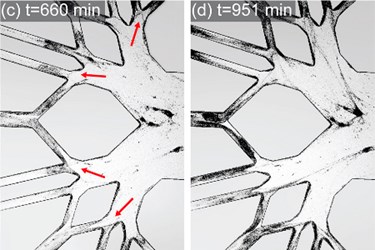Researchers Discover How Pathogen Clogs Medical Devices, Infects Patients
By Joel Lindsey

A team of researchers from Princeton University has studied the growth patterns of the Staphylococcus aureus pathogen — notorious for causing infections in patients using medical devices — and may have pinpointed what allows these bacteria to so effectively become both disruptive to treatment and infectious.
“We have shown that Staphylococcus aureus can create slimy, thread-like biofilm streamers in environments that mimic the physical and chemical conditions of medical devices such as stents and catheters,” Howard Stone, professor of mechanical and aerospace engineering at Princeton, said in a press release. “By studying the morphologies and growth dynamics of the bacteria, we believe there is potential to develop novel methods that prevent diseases associated with this notorious pathogen.”
In their experiments, Stone and the research team simulated medical devices by creating physical environments with curvy channels and multiple networks through which liquids could flow. Their goal was to study how variables such as geometry, fluid flow, and surface chemistry affect the formation and growth of the pathogen.
The scientists examined four different strains of S. aureus. They marked the bacteria cells with a fluorescent dye and then took a series of high-resolution images of these cells as they reacted to the flow of liquids through the microfluidic channels and networks of the simulated medical devices.
They found that the bacteria were able to quickly expand and grow, colonizing into large groups of biofilm that then deployed both a biological glue and thin, slimy, thread-like structures the researchers have called streamers. These streamers trapped other particles and cells passing by, eventually clogging the device and restricting the flow of liquid through the device’s channels.
The researchers also found that if human plasma was present at the site, as it is in many real-world infectious scenarios, the bacteria developed streamers even more rapidly.
“The different dynamics of biofilm formation may result from different mechanisms, and different flows of the biofilm matrix, which are research directions we are currently pursuing” said Stone.
Results from the team’s initial tests have been published recently in the New Journal of Physics.
Image credit: Minyoung Kevin Kim et al 2014 New J. Phys. 16 065024 doi:10.1088/1367-2630/16/6/065024. Used under a Attribution 3.0 Unported license: http://creativecommons.org/licenses/by/3.0/
